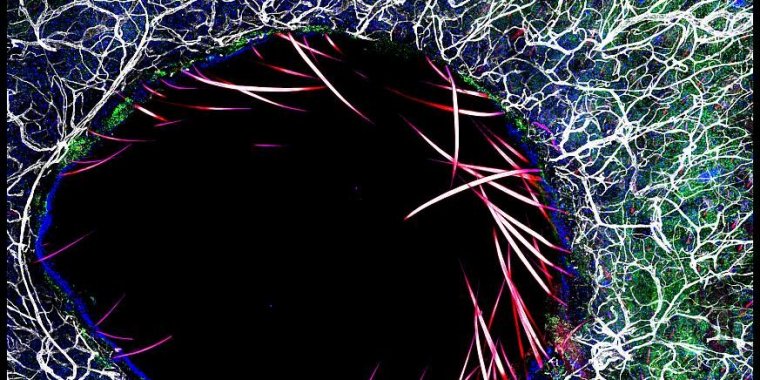| Health / Health News |
Scientists find microbes on the skin of mice promote tissue healing, immunity
Beneficial bacteria on the skin of lab mice work with the animals’ immune systems to defend against disease-causing microbes and accelerate wound healing, according to new research from scientists at the National Institute of Allergy and Infectious Diseases.

Immunofluorescent image of immune cells surrounding a skin wound, enriched in the beneficial bacteria S. epidermidis. Image credit: NIAID
Like humans and other mammals, mice are inhabited by large, diverse microbial populations collectively called the microbiome. While the microbiome is believed to have many beneficial functions across several organ systems, little is known about how the immune system responds to these harmless bacteria.
To investigate, NIAID scientists observed the reaction of mouse immune cells to Staphylococcus epidermidis, a bacterium regularly found on human skin that does not normally cause disease.
To their surprise, immune cells recognized S. epidermidis using evolutionarily ancient molecules called non-classical MHC molecules, which led to the production of unusual T cells (link is external) with genes associated with tissue healing and antimicrobial defense.
In contrast, immune cells recognize disease-causing bacteria with classical MHC molecules, which lead to the production of T cells that stoke inflammation.
Researchers then took skin biopsies from two groups of mice—one group that had been colonized by S. epidermidis and another that had not. Over five days, the group that had been exposed to the beneficial bacteria experienced more tissue repair at the wound site and less evidence of inflammation.
The team plans to next probe whether non-classical MHC molecules recognize friendly microbes on the skin of other mammals, including humans, and similarly benefit tissue repair.
Eventually, mimicking the processes initiated by the microbiome may allow clinicians to accelerate wound healing and prevent dangerous infections, the researchers note. (National Institutes of Health)
YOU MAY ALSO LIKE





